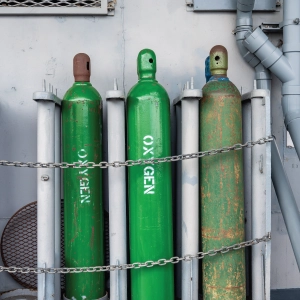RCRA Permitted Treatment, Storage, and Disposal (TSD) Facilities

The Resource Conservation and Recovery Act (RCRA) has developed extensive guidance on hazardous and non-hazardous waste management in collaboration with the Environmental Protection Agency (EPA) under Congress directive. One focus of the RCRA waste management framework is the proper management of hazardous waste in treatment, storage, and disposal (TSD) facilities to ensure the safety and health of people and ensure environmentally friendly operations to safeguard natural resources.
The Hazardous Waste Operations and Emergency Response (HAZWOPER) standard developed by the Occupational Health and Safety Administration (OSHA) guides the health and safety of workers engaged in hazardous waste management activities carried out in workplaces that utilize hazardous material also referred to as HAZMAT. As part of its guidance, the HAZWOPER standard has dedicated one section to tackle the safety and health of workers employed in hazardous waste operations in RCRA permitted TSD facilities. As such, most of the guidance is aligned to the requirements as set out by the RCRA.
Two regulatory bodies enacting standards, guidelines, and regulations to direct the operations of employees working in TSD facilities are evidence of the importance given to safeguarding employee health and safety in TSD facilities.
What are TSD Facilities?
TSD facilities offer services that carry out hazardous waste management by the treatment, storage, or disposal of hazardous wastes and hazardous waste materials using different pre-approved methods. TSD facilities may focus their waste services and specialize in one or more of the activities related to waste treatment, storage, and hazardous waste disposal services. As such, TSD facilities are also often referred to as hazardous waste management facilities.
What Operations Are Performed by TSD Facilities?
Operations performed by TSD facilities constitute the following:
- Treatment facilities provide final waste treatment for HAZMAT using chemicals, or incineration or oxidation, or a physical waste-processing system to reduce, remove, or destroy the contaminated element of the hazardous waste. In some cases, this recycled waste may then be re-used in other manufacturing processes or may even be used for other purposes. An example is the use of treated wastewater to clean factory floors.
- Storage facilities would temporarily hold quantities of hazardous waste produced on or off-site until they are treated or disposed of. According to RCRA regulations, the storage of contaminated waste must be done in containers, tanks, containment buildings, drip pads, waste piles, or surface impoundments.
- Disposal facilities permanently hold the hazardous waste in landfills using specifically designed and constructed units that safeguard groundwater and surface water resources. (EPA, 2019)
What Regulations Apply to TSD Facilities?
Since TSD facilities handle large quantities of hazardous waste and perform tasks that are of a higher risk level for employees’ safety and health, TSD facilities are rigorously regulated. The EPA states, that “TSD facility requirements establish generic facility management standards, specific provisions governing hazardous waste management units, and additional precautions designed to protect soil, groundwater, and air resources” (EPA, 2020).
Under its HAZWOPER standard, OSHA specifies TSD facilities to follow the regulations of the Code of Federal Regulations (CFR) Title 40 parts 264 and 265 consistent with the RCRA regulations or of agencies under agreement with the United States EPA to implement RCRA regulations.

What Training Is Needed for Employees of TSD Facilities?
Training required for employees working in TSD facilities mainly follows the RCRA training requirements. Even the EPA and HAZWOPER defer to the training requirements as guided by the RCRA. The details are given below.
RCRA Training
For an overview of the online RCRA training requirements, review our blog article titled - Overview of RCRA Online Training.
HAZWOPER Training
According to the HAZWOPER standard, personnel involved in hazardous waste operations in TSD facilities require training if their work tasks expose them to hazards or there is a reasonable probability of employees being exposed to worksite safety or health hazards. According to OSHA HAZWOPER regulation number 1910.120(p)(7) of Subpart H, an employer must develop and implement training programs for new employees, current employees, and trainers. The specifications of training programs for new and existing employees are explained below.
24 Hour Initial TSDF Operations Online Training Course
According to the OSHA HAZWOPER standard, an employer must develop and implement a 24-hour TSDF operations training program for new employees as part of its overall health and safety program plan. Employees must be trained on the regulatory requirements, different types of hazards they can be exposed to at the worksite, how to minimize hazard exposure, decontamination process, how to use personal protective equipment (PPE), correct use of respiratory protection units, medical surveillance and toxicology, how to safely use hazardous waste storage containers, and how to respond to worksite emergencies.
Such training may be conducted online. Our dedicated course for TSDF operations, the OSHA 24-hour initial online training course for new employees of TSD facilities gives a comprehensive understanding of how operations at TSD facilities may be conducted safely by workers.
On completion of the initial 24-hour TSDF operations online training course, employees must be provided with a certificate of completion.
8 Hour TSDF Operations Refresher Online Training Course
For current employees, or employees who have previously taken the initial 24-hour TSDF HAZWOPER (p) series online training course, or for those employees who have prior field experience of working at TSD facilities, the OSHA HAZWOPER standard recommends an 8-hour annual refresher training when continuing to work at TSD facilities. This training course must be taken annually to ensure that employees are updated and able to retain their knowledge while they continue to safeguard their health and the safety of their co-workers at TSD facilities.
The areas to be covered are the same as those topics in the 24-hour TSDF operations online training course, but the reduced training hours of this online course will limit the breadth and depth of information included in the training program.
Such training may be conducted online. Our OSHA 8-hour TSDF operations refresher online training course is available online and enables employees working with hazardous waste to refresh and renew their understanding of how operations at TSD facilities may be conducted safely. It must be noted that this 8-hour online refresher training course must be taken within 12 months of completing the initial 24-hour TSD facilities initial training course or the previous refresher 8-hour HAZWOPER TSDF training program.
On completion of the 8-hour HAZWOPER TSDF operations refresher online training course, employees must be provided with a certificate of completion.
HAZWOPER’s Requirements Regarding Clean Up at TSD Facilities
Generally, workers of TSD facilities are not expected to be involved in clean-up operations of hazardous wastes. However, the OSHA HAZWOPER standard specifies that in instances where an employee may be exposed to safety and health hazards due to a clean-up operation at TSD facilities, they require to have completed the initial OSHA 24-hour HAZWOPER TSDF operations online training course and thereafter enroll in and complete the OSHA 8-hour HAZWOPER TSDF operations refresher online training course.
EPA Training
The EPA has developed a comprehensive training module for TSD facilities. This training module is aligned to the RCRA's cradle-to-grave concept. It encompasses training requirements for TSD facilities that are part of the value chain of waste management, starting with the waste generator and including the hazardous waste transporters. This training module covers an overview of the general TSDF standards found in 40 CFR Part 264/265, Subparts A through E (EPA, 2005, p.1).
References
EPA. (2005, September). Training Module: Introduction to Treatment, Storage, and Disposal Facilities (40 CFR Parts 264/265, Subpart A-E). [PDF]. Website. https://www.epa.gov/sites/production/files/2015-07/documents/tsdf05.pdf
EPA. (2019, November 21, updated). What is a Hazardous Waste Management Facility? Website. https://www.epa.gov/hwpermitting/hazardous-waste-management-facilities-and-units#facility
EPA. (2020, February 19, updated). Hazardous Waste Recycling, Treatment, Storage, and Disposal. Website. https://www.epa.gov/hw/learn-basics-hazardous-waste#recycling

 EN |
EN |  ES
ES






























































































































